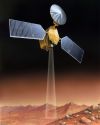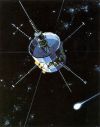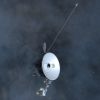Emily Lakdawalla • Mar 31, 2010
What's up in the solar system in April 2010
This month, we can expect lots of cool images of icy moons from Cassini, which will have close encounters with Dione (April 7, at 500 kilometers) and Enceladus (April 28, 100 kilometers), and more distant encounters with nearly every other iceball flying around the Saturn system inside Titan's orbit. At the same time, rover fans will be waiting on tenterhooks for each week's check-in with Spirit to see if the cold, cold rover manages to squeeze enough power out of her solar cells to stay out of hibernation mode. And it'll (hopefully) be operations as usual for the quieter workhorses like Mars Reconnaissance Orbiter, Lunar Reconnaissance Orbiter, Mars Express, Venus Express, Mars Odyssey, and Opportunity.
So, what's going on across our planetary backyard?
In the inner solar system:
 The MESSENGER spacecraft is cruising along, with less than a year remaining until Mercury orbit insertion (which is planned for March 18, 2011). While they prepare for their orbital mission, they're getting lots of craters formally named by the IAU; see here and here for maps and images.
The MESSENGER spacecraft is cruising along, with less than a year remaining until Mercury orbit insertion (which is planned for March 18, 2011). While they prepare for their orbital mission, they're getting lots of craters formally named by the IAU; see here and here for maps and images.
 Venus Express remains healthy (as of March 9) in orbit at Venus. The mission has recently begun some interesting and creative atmospheric drag experiments with the spacecraft. As it orbits Venus, its periapsis altitude tends to decrease, bringing it as close as 175 kilometers above Venus' surface. At the lowest altitude, the spacecraft begins to feel a tiny bit of drag from impinging on the top of the atmosphere. Engineers can determine the density of the atmosphere at this altitude through careful measurements of the changes to the spacecraft's speed. But they're actually getting trickier than that: by tilting the solar panels in different directions, they are actually getting atmospheric drag to impart a torque to the spacecraft. The spacecraft automatically corrects for this, using its reaction wheels to correct the spacecraft orientation. Using the amount of reaction wheel torque needed to maintain the spacecraft attitude to determine the density of the atmosphere permits a finer measurement than just tracking the spacecraft.
Venus Express remains healthy (as of March 9) in orbit at Venus. The mission has recently begun some interesting and creative atmospheric drag experiments with the spacecraft. As it orbits Venus, its periapsis altitude tends to decrease, bringing it as close as 175 kilometers above Venus' surface. At the lowest altitude, the spacecraft begins to feel a tiny bit of drag from impinging on the top of the atmosphere. Engineers can determine the density of the atmosphere at this altitude through careful measurements of the changes to the spacecraft's speed. But they're actually getting trickier than that: by tilting the solar panels in different directions, they are actually getting atmospheric drag to impart a torque to the spacecraft. The spacecraft automatically corrects for this, using its reaction wheels to correct the spacecraft orientation. Using the amount of reaction wheel torque needed to maintain the spacecraft attitude to determine the density of the atmosphere permits a finer measurement than just tracking the spacecraft.
 Lunar Reconnaissance Orbiter is busily mapping the Moon from its science orbit. Last month they released their first six months or so of data to the Planetary Data System. I am still working on figuring out how best to access the image data; when I've solved the problems, I'll post about it! In the meantime, the camera team is releasing captioned images regularly, and the laser altimeter team is releasing image every week.
Lunar Reconnaissance Orbiter is busily mapping the Moon from its science orbit. Last month they released their first six months or so of data to the Planetary Data System. I am still working on figuring out how best to access the image data; when I've solved the problems, I'll post about it! In the meantime, the camera team is releasing captioned images regularly, and the laser altimeter team is releasing image every week.
On to Mars:
 Out at Mars, it's late southern hemisphere autumn (Ls 71°). Today it is Mars Exploration Rover Spirit sol 2218 and Opportunity sol 2197. As of the latest JPL update (dated March 22), Spirit's solar panels were only putting out 134 Watt-hours, but all systems were green. There was one ominous item in that update: "A change was noticed on Sol 2203 (March 15, 2010), in the behavior of the battery survival heaters. The implications are not known, but it is being investigated." The rover is only communicating with Earth once a week now in order to save energy. Opportunity, meanwhile, is doing just fine, currently located next to a double crater (which is now named "San Antonio"), but unlikely to spend much time there. Here is Eduardo Tesheiner's latest route map and Google Earth kml file for Opportunity.
Out at Mars, it's late southern hemisphere autumn (Ls 71°). Today it is Mars Exploration Rover Spirit sol 2218 and Opportunity sol 2197. As of the latest JPL update (dated March 22), Spirit's solar panels were only putting out 134 Watt-hours, but all systems were green. There was one ominous item in that update: "A change was noticed on Sol 2203 (March 15, 2010), in the behavior of the battery survival heaters. The implications are not known, but it is being investigated." The rover is only communicating with Earth once a week now in order to save energy. Opportunity, meanwhile, is doing just fine, currently located next to a double crater (which is now named "San Antonio"), but unlikely to spend much time there. Here is Eduardo Tesheiner's latest route map and Google Earth kml file for Opportunity.
 After the excitement of last month's close flybys of Phobos by ESA's Mars Express, I expect that mission to be quiet for a little while. But not for that long: there are two more seasons worth of Phobos encounters coming, with the closest encounters taking place on August 24, 2010 and January 9, 2011. Meanwhile, the Mars Webcam has continued posting new full-globe photos of Mars nearly every day.
After the excitement of last month's close flybys of Phobos by ESA's Mars Express, I expect that mission to be quiet for a little while. But not for that long: there are two more seasons worth of Phobos encounters coming, with the closest encounters taking place on August 24, 2010 and January 9, 2011. Meanwhile, the Mars Webcam has continued posting new full-globe photos of Mars nearly every day.
 Mars Reconnaissance Orbiter is humming along in normal science operations. The latest MARCI weather report mentions lots of water ice clouds but clear skies for both solar-powered rovers. The latest captioned image releases from HiRISE include this cool chloride (salt) rich site that's of interest as a future landing site for MSL.
Mars Reconnaissance Orbiter is humming along in normal science operations. The latest MARCI weather report mentions lots of water ice clouds but clear skies for both solar-powered rovers. The latest captioned image releases from HiRISE include this cool chloride (salt) rich site that's of interest as a future landing site for MSL.
 NASA's Mars Odyssey remains the longest-lived spacecraft in orbit at Mars. You can see the latest from its THEMIS instrument here. I like this one of layered deposits on the floor of Coprates Catena.
NASA's Mars Odyssey remains the longest-lived spacecraft in orbit at Mars. You can see the latest from its THEMIS instrument here. I like this one of layered deposits on the floor of Coprates Catena.
Exploring Saturn:
 NASA's Cassini mission had a relatively quiet month last month, but there's some exciting stuff this month: a somewhat distant targeted Titan flyby on April 5 sets up a close targeted encounter, at an altitude of only 504 kilometers, with Dione, on April 7. That's followed by a Voyager-class passes by Mimas and Tethys, at 97,000 and 71,000 kilometers' distance, respectively. Then, at the very end of the month, April 28, there's a 103-kilometer shot past Enceladus. Busy month! The Dione, Mimas and Tethys flybys are part of rev 129, the Enceladus encounter part of rev 130. Both of these orbits are basically within Saturn's ring plane (that's how there can be all these moon flybys) and have periods slightly longer than the 16 days of Titan's orbit. The orbit will stay in the ring plane until June.
NASA's Cassini mission had a relatively quiet month last month, but there's some exciting stuff this month: a somewhat distant targeted Titan flyby on April 5 sets up a close targeted encounter, at an altitude of only 504 kilometers, with Dione, on April 7. That's followed by a Voyager-class passes by Mimas and Tethys, at 97,000 and 71,000 kilometers' distance, respectively. Then, at the very end of the month, April 28, there's a 103-kilometer shot past Enceladus. Busy month! The Dione, Mimas and Tethys flybys are part of rev 129, the Enceladus encounter part of rev 130. Both of these orbits are basically within Saturn's ring plane (that's how there can be all these moon flybys) and have periods slightly longer than the 16 days of Titan's orbit. The orbit will stay in the ring plane until June.
Quietly cruising:
 ESA's Rosetta is cruising along toward its next cruise milestone, a flyby of the asteroid Lutetia in July 2010. That'll be the last world it'll visit before its May 2014 rendezvous with comet Churyumov-Gerasimenko.
ESA's Rosetta is cruising along toward its next cruise milestone, a flyby of the asteroid Lutetia in July 2010. That'll be the last world it'll visit before its May 2014 rendezvous with comet Churyumov-Gerasimenko.
 The International Cometary Explorer remains on course for a return visit to Earth in 2014. When it does, ICE can be returned to a Sun-Earth L1 halo orbit, or can use multiple Earth swingbys to encounter Comet Wirtanen during its near-Earth apparition in December 2018.
The International Cometary Explorer remains on course for a return visit to Earth in 2014. When it does, ICE can be returned to a Sun-Earth L1 halo orbit, or can use multiple Earth swingbys to encounter Comet Wirtanen during its near-Earth apparition in December 2018.
![]() NASA's Dawn is now in the asteroid belt for good, and is steadily thrusting with its ion engines, patiently propelling itself toward a rendezvous with Vesta in July 2011.
NASA's Dawn is now in the asteroid belt for good, and is steadily thrusting with its ion engines, patiently propelling itself toward a rendezvous with Vesta in July 2011.
 NASA's Deep Impact is cruising toward its November 4 flyby of comet 103P/Hartley 2. The latest status report, from March 3, doesn't say that there's anything out of the ordinary; they're preparing for the encounter.
NASA's Deep Impact is cruising toward its November 4 flyby of comet 103P/Hartley 2. The latest status report, from March 3, doesn't say that there's anything out of the ordinary; they're preparing for the encounter.
 All systems on NASA's Stardust are "nominal" as less than a year remains until its flyby of comet Tempel 1. Closest approach will happen at 8:42 p.m. PST on February 14, 2011, or 04:42 February 15 UTC.
All systems on NASA's Stardust are "nominal" as less than a year remains until its flyby of comet Tempel 1. Closest approach will happen at 8:42 p.m. PST on February 14, 2011, or 04:42 February 15 UTC.
 Hayabusa is still on track to return to Earth later this year; it has completed powered flight and has only some minor course correction to do in order to return its sample capsule to Earth on June 13.
Hayabusa is still on track to return to Earth later this year; it has completed powered flight and has only some minor course correction to do in order to return its sample capsule to Earth on June 13.
 NASA's New Horizons has 15.63 AU to go to reach Pluto. It's still on course for a January to July 2015 encounter with the Pluto and Charon system. The spacecraft is presently in the middle of a long hibernation period with only weekly beacon and monthly telemetry reports until it wakes up again in May.
NASA's New Horizons has 15.63 AU to go to reach Pluto. It's still on course for a January to July 2015 encounter with the Pluto and Charon system. The spacecraft is presently in the middle of a long hibernation period with only weekly beacon and monthly telemetry reports until it wakes up again in May.
And beyond:
 Finally, NASA's Voyager 1 and 2 spacecraft were still responding to commands from Earth as of January 29. Both have now crossed the "termination shock," where the solar wind slows down as it impinges upon the interstellar medium.
Finally, NASA's Voyager 1 and 2 spacecraft were still responding to commands from Earth as of January 29. Both have now crossed the "termination shock," where the solar wind slows down as it impinges upon the interstellar medium.
Some other milestones to take note of this month, taken mostly from JPL's Space Calendar:
- April 8: Mercury will be at its greatest eastern elongation, 19 degrees above the western horizon after sunset.
- April 12 is Yuri's Night!
- April 15: President Obama's Florida Space Summit -- will we have a new "vision?"
Support our core enterprises
Your support powers our mission to explore worlds, find life, and defend Earth. You make all the difference when you make a gift. Give today!
Donate

 Explore Worlds
Explore Worlds Find Life
Find Life Defend Earth
Defend Earth

